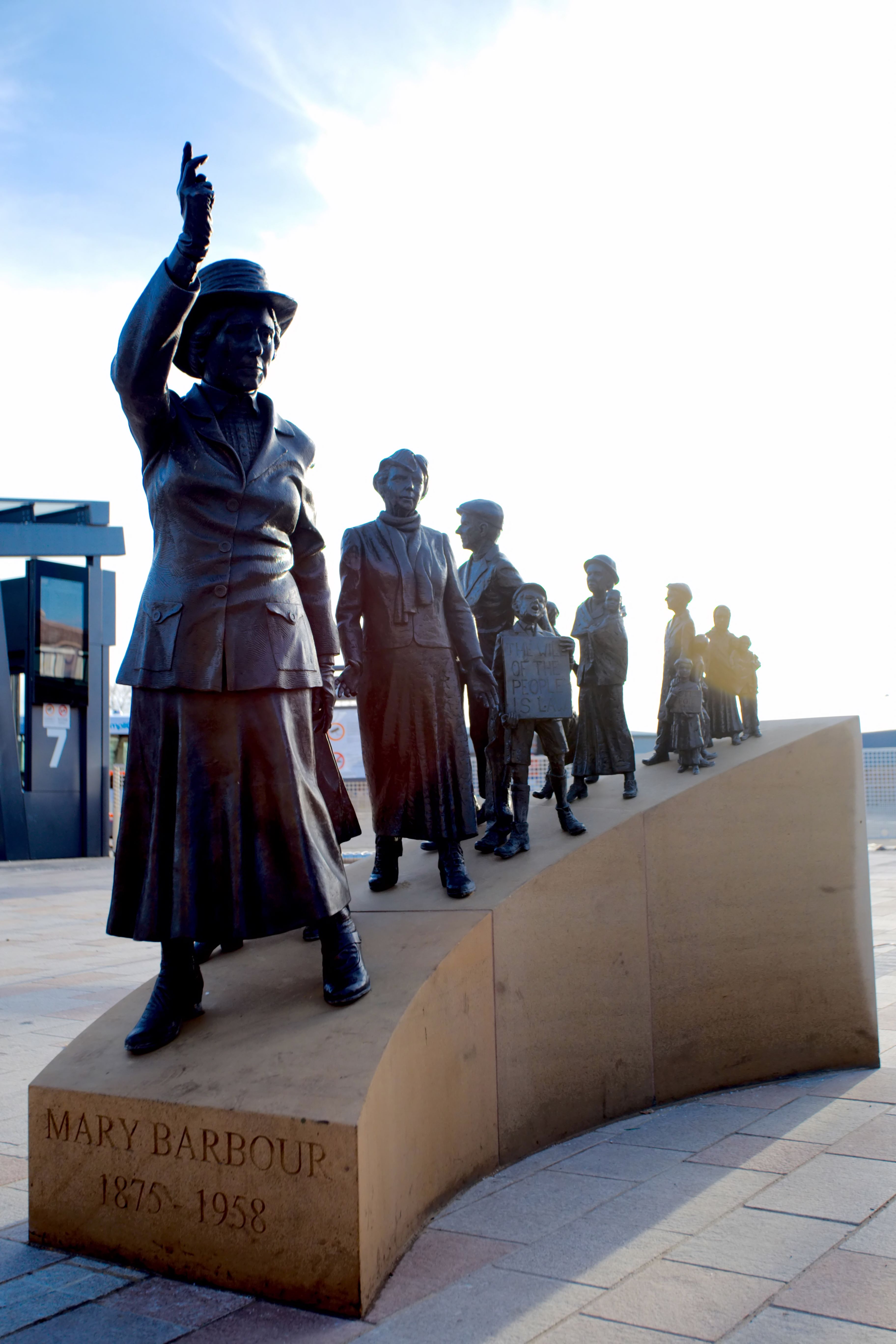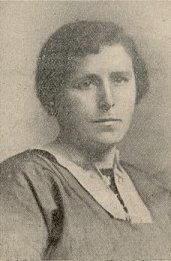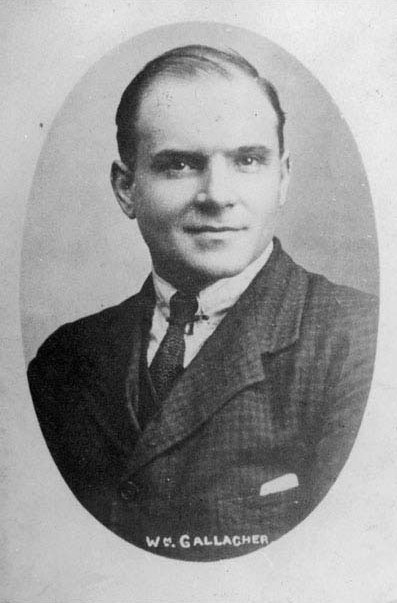|
Agnes Dollan
Agnes Johnston Dollan MBE ( Moir; 16 August 1887 – 16 July 1966), also known as Agnes, Lady Dollan, was a Scottish suffragette and political activist. She was a leading campaigner during the Glasgow Rent Strikes, and a founding organiser of the Women's Peace Crusade. In 1919, she was the first woman selected by the Labour party to stand for election to Glasgow Town Council, and later became Lady Provost of Glasgow. Early life Dollan was born on Springburn Road in Springburn, Glasgow on 16 August 1887 to Anne Wilkinson and Henry Moir, a blacksmith in the locomotive works. She was one of eleven children. Dollan attended school locally until the age of eleven before being forced to leave due to family poverty. Dollan also attended the Socialist Sunday Schools, where she "graduated as a Socialist". On leaving school, Dollan went first to work in a factory before becoming a Post Office telephone operator. During this latter job, Dollan joined the Women's Labour League ... [...More Info...] [...Related Items...] OR: [Wikipedia] [Google] [Baidu] |
Springburn
Springburn ( gd, Allt an Fhuairainn) is an inner-city district in the north of the Scottish city of Glasgow, made up of generally working-class households. Springburn developed from a rural hamlet at the beginning of the 19th century. Its industrial expansion began with the establishment of a chemical works by Charles Tennant on the newly opened Monkland Canal at nearby St. Rollox in 1799, which later became part of the United Alkali Company. Later in the 19th century, the construction of railway lines through the area led to the establishment of railway works and the village became a parish in its own right. The Garnkirk and Glasgow Railway first opened in 1831 to supply the St. Rollox Chemical Works and the Edinburgh & Glasgow Railway was opened in 1842. Later, the City Union Line was extended to Springburn in 1871, and the Hamiltonhill Branch Line opened in 1894. Initially located outside the Glasgow boundary, the core area was eventually absorbed by the city in 1872 and o ... [...More Info...] [...Related Items...] OR: [Wikipedia] [Google] [Baidu] |
Mary Reid Macarthur
Mary Reid Anderson (née Macarthur; 13 August 1880 – 1 January 1921) was a Scottish suffragist (although at odds with the national groups who were willing to let a minority of women gain the franchise) and was a leading trades unionist. She was the general secretary of the Women's Trade Union League and was involved in the formation of the National Federation of Women Workers and National Anti-Sweating League. In 1910, Macarthur led the women chain makers of Cradley Heath to victory in their fight for a minimum wage and led a strike to force employers to implement the rise. Around 1901, Macarthur became a trade unionist after hearing a speech made by John Turner about how badly some workers were being treated by their employers. She became secretary of the Ayr branch of the Shop Assistants' Union, and her interest in this union led to her work for the improvement of women's labour conditions. In 1902 Mary became friends with Margaret Bondfield who encouraged her to atten ... [...More Info...] [...Related Items...] OR: [Wikipedia] [Google] [Baidu] |
Representation Of The People Act 1918
The Representation of the People Act 1918 was an Act of Parliament passed to reform the electoral system in Great Britain and Ireland. It is sometimes known as the Fourth Reform Act. The Act extended the franchise in parliamentary elections, also known as the right to vote, to men aged over 21, whether or not they owned property, and to women aged over 30 who resided in the constituency or occupied land or premises with a rateable value above £5, or whose husbands did."6 February 1918: Women get the vote for the first time" BBC, 6 February 2018. At the same time, it extended the local government franchise to include women aged over 21 on the same terms as men. It came into effect at the [...More Info...] [...Related Items...] OR: [Wikipedia] [Google] [Baidu] |
The Sunday Post
''The Sunday Post'' is a weekly newspaper published in Dundee, Scotland, by DC Thomson, and characterised by a mix of news, human interest stories and short features. The paper was founded in 1914 and has a wide circulation across Scotland, Northern Ireland, and parts of Northern England. The current editor is Richard Prest. Sales of the ''Sunday Post'' in Scotland were once so high that it was recorded in ''The Guinness Book of Records'' as the newspaper with the highest per capita readership penetration of anywhere in the world; in 1969, its total estimated readership of 2,931,000 represented more than 80 per cent of the entire population of Scotland aged 16 and over. ''The Sunday Post'' has seen a decline in circulation in common with other print titles; in 1999 circulation was around 700,000, dropping to just under 143,000 in December 2016, with a year-on-year fall of 13.5% recorded for 2016. 2007 saw DC Thomson launch an advertising drive for ''The Sunday Post'', primar ... [...More Info...] [...Related Items...] OR: [Wikipedia] [Google] [Baidu] |
Justice Of The Peace
A justice of the peace (JP) is a judicial officer of a lower or ''puisne'' court, elected or appointed by means of a commission ( letters patent) to keep the peace. In past centuries the term commissioner of the peace was often used with the same meaning. Depending on the jurisdiction, such justices dispense summary justice or merely deal with local administrative applications in common law jurisdictions. Justices of the peace are appointed or elected from the citizens of the jurisdiction in which they serve, and are (or were) usually not required to have any formal legal education in order to qualify for the office. Some jurisdictions have varying forms of training for JPs. History In 1195, Richard I ("the Lionheart") of England and his Minister Hubert Walter commissioned certain knights to preserve the peace in unruly areas. They were responsible to the King in ensuring that the law was upheld and preserving the " King's peace". Therefore, they were known as "keepers of th ... [...More Info...] [...Related Items...] OR: [Wikipedia] [Google] [Baidu] |
Glasgow Green
Glasgow Green is a park in the east end of Glasgow, Scotland, on the north bank of the River Clyde. Established in the 15th century, it is the oldest park in the city. It connects to the south via the St Andrew's Suspension Bridge. History In 1450, King James II granted the parkland to Bishop William Turnbull and the people of Glasgow. The Green then looked quite different from the Green today. It was an uneven, swampy area made up of several distinct "greens" (separated by the Camlachie and Molendinar Burns): the High Green; the Low Green; the Calton Green; and the Gallowgate Green. In the centuries that followed, the parkland was used for grazing, washing and bleaching linen, drying fishing nets, and recreational activities like swimming. In 1732, Glasgow’s first ''steamie'', called ''the Washhouse'', opened on the banks of the Camlachie Burn. From 25 December 1745 to 3 January 1746, Bonnie Prince Charlie's army camped in ''Flesher's Haugh'' (privately owned at the time, ... [...More Info...] [...Related Items...] OR: [Wikipedia] [Google] [Baidu] |
Mary Barbour Statue - Front View
Mary may refer to: People * Mary (name), a feminine given name (includes a list of people with the name) Religious contexts * New Testament people named Mary, overview article linking to many of those below * Mary, mother of Jesus, also called the Blessed Virgin Mary * Mary Magdalene, devoted follower of Jesus * Mary of Bethany, follower of Jesus, considered by Western medieval tradition to be the same person as Mary Magdalene * Mary, mother of James * Mary of Clopas, follower of Jesus * Mary, mother of John Mark * Mary of Egypt, patron saint of penitents * Mary of Rome, a New Testament woman * Mary, mother of Zechariah and sister of Moses and Aaron; mostly known by the Hebrew name: Miriam * Mary the Jewess one of the reputed founders of alchemy, referred to by Zosimus. * Mary 2.0, Roman Catholic women's movement * Maryam (surah) "Mary", 19th surah (chapter) of the Qur'an Royalty * Mary, Countess of Blois (1200–1241), daughter of Walter of Avesnes and Margaret of Blois * Mar ... [...More Info...] [...Related Items...] OR: [Wikipedia] [Google] [Baidu] |
Mary Jeff
Mary Jeff (1873-1941) was a Scottish activist and politician who was involved in the Glasgow rent strike. Early life and education Mary Jeff was born Mary Russell Watson in Coatbridge, Lanarkshire in 1873. She moved to Govan in 1896, and lived there with her husband, printer Andrew Jeff, and their three sons. Community Activism and Political career Mary and her husband were active in their community. They both had a key role in the Govan rent strike, Andrew as chair of the South Govan Tenants Committee, and Mary as part of the group of women who campaigned against eviction, and orchestrated the defence against bailiffs. Other women involved in this activity were Mary Barbour, Agnes Dollan, Mary Laird and Helen Crawfurd. She was a member of the Kinning Park Co-operative Women's Guild and the chairwoman of the Ladies section of the Govan War Memorial Committee. Two of her three sons had served in World War I, one of whom died. She was elected to Govan parish council in 1919, and ... [...More Info...] [...Related Items...] OR: [Wikipedia] [Google] [Baidu] |
Mary Burns Laird
Mary Laird ( Burns; died 1944) was a founding member and first President of the Glasgow Women's Housing Association, a President of the Partick Branch of the Women's Labour League, associated with the Red Clydeside movement, and supported the Glasgow Rent Strikes of 1915 alongside Mary Barbour, Agnes Dollan, Mary Jeff and Helen Crawfurd. Laird went on to participate in wider social activism for women and children's rights. Biography Mary Burns Laird was born in 1864 to Margaret Walker and Hugh Burns, who were both born in Ireland. In 1884, she married John Laird, who was a ship builder's clerk. The wedding took place in Kinning Park, Glasgow. Laird was a sewing machinist. Her father, Hugh was a Deputy Harbourmaster at the time of her marriage. In the 1891 and 1901 censuses the family lived at Edward Street, Barony and in the 1911 census at Blantyre Road, Anderston. According to the 1911 census entry Laird and her husband, John had had six children, two of whom were still li ... [...More Info...] [...Related Items...] OR: [Wikipedia] [Google] [Baidu] |
Helen Crawfurd
Helen Crawfurd ( Jack, later Anderson; 9 November 1877 – 18 April 1954) was a Scottish suffragette, rent strike organiser, Communist activist and politician. Born in Glasgow, she was brought up there and in London. Biography Born Helen Jack at 175 Cumberland Street in the Gorbals area of Glasgow, her parents were Helen L. ( Kyle) and William Jack. Her mother worked a steam-loom before she wed. Helen's family moved to Ipswich while she was young. Crawfurd later went to school in London and Ipswich before moving back to Glasgow as a teenager. Crawfurd's father, a master baker, was a Catholic, but converted to the Church of Scotland and became a conservative trade unionist. Initially religious herself and a Sunday School teacher, Crawfurd felt a call to be married at 21 to the 67-year-old widower Alexander Montgomerie Crawfurd (29 August 1828 – 31 May 1914), a Church of Scotland minister and family friend. but he became increasingly radical.A. T. Lane, ed., ''Biographical Dic ... [...More Info...] [...Related Items...] OR: [Wikipedia] [Google] [Baidu] |
Mary Barbour
Mary Barbour ( Rough; 20 February 1875 – 2 April 1958) was a Scottish political activist, local councillor, bailie and magistrate. Barbour was closely associated with the Red Clydeside movement in the early 20th century and especially for her role as the main organiser of the women of Govan who took part in the rent strikes of 1915.Audrey Canning, ‘Barbour , Mary (1875–1958)’, Oxford Dictionary of National Biography, Oxford University Press, 2004; online edn, May 200accessed 14 Feb 2014/ref> Life Barbour was born on 20 February 1875 at 37 New Street, Kilbarchan to Jean (Gavin) and James Rough, a handloom carpet weaver. She was the third of seven children. Barbour attended school until she was fourteen years old. In 1887, the family moved to the village of Elderslie and Barbour worked as a thread twister, eventually becoming a carpet printer. On 28 August 1896, Mary Rough married an engineer, David Barbour (2 May 1873 – 13 November 1957), at Wallace Place, Elderslie. ... [...More Info...] [...Related Items...] OR: [Wikipedia] [Google] [Baidu] |
Red Clydeside
Red Clydeside was the era of political radicalism in Glasgow, Scotland, and areas around the city, on the banks of the River Clyde, such as Clydebank, Greenock, Dumbarton and Paisley, from the 1910s until the early 1930s. Red Clydeside is a significant part of the history of the labour movement in Britain as a whole, and Scotland in particular. Some newspapers of the time used the term "Red Clydeside" to refer, largely derisively, to the groundswell of popular and political radicalism that had erupted in Scotland. A confluence of charismatic individuals, organised movements and socio-political forces led to Red Clydeside, which had its roots in working-class opposition to Britain's participation in the First World War, although the area had a long history of political radicalism going back to the Society of the Friends of the People and the "Radical War" of 1820. 1911 strike at Singer The 11,000 workers at the largest Singer sewing machines factory, in Clydebank, went on str ... [...More Info...] [...Related Items...] OR: [Wikipedia] [Google] [Baidu] |




.jpg)


